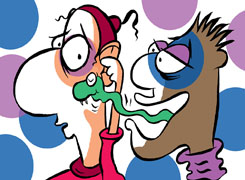Ramalingam Kalirajan |10902 Answers |Ask -Follow
Mutual Funds, Financial Planning Expert - Answered on Jul 04, 2024
He has an MBA in finance from the University of Madras and is a certified financial planner.
He is the director and chief financial planner at Holistic Investment, a Chennai-based firm that offers financial planning and wealth management advice.... more

Hi sir, I'm 29 years old and I'm working professional and my salary is 27000 PM. Currently I'm doing 5000 pm SIP with step up in Nifty 50 and Nasdaq index from last 1 year. I'm up for long term. So please guide me how should i invest so i can secure my future and manage other expenses and making some retirement fund and make a good corpus . Should i diversify my investment?? And where to invest?? Or i need to switch to another mutual funds or add some too??
Current Investments and Goals
Income and Investments
Monthly Salary: Rs. 27,000
SIP Investments: Rs. 5,000 per month in Nifty 50 and Nasdaq index funds
Your goal is to secure your future, manage expenses, and create a retirement fund. Diversifying your investments can help achieve these goals.
Evaluating Your Current Investments
Index Funds: Nifty 50 and Nasdaq
Index funds like Nifty 50 and Nasdaq are good for low-cost, broad-market exposure. However, they have limitations:
Passive Management
Index funds track the market. They don’t attempt to outperform it, which limits potential returns.
Market Volatility
Index funds are subject to market volatility. During downturns, they can suffer significant losses.
Benefits of Actively Managed Funds
Why Consider Actively Managed Funds?
Professional Management
Actively managed funds are overseen by expert fund managers. They strive to outperform the market by selecting high-potential securities.
Strategic Allocation
Fund managers adjust portfolios based on market conditions. This can provide better returns than passive index funds.
Diversification
Actively managed funds often invest in a mix of securities. This diversification reduces risk compared to focusing solely on index funds.
Diversifying Your Investment Portfolio
Types of Mutual Funds
Equity Funds
Equity funds invest in stocks. They offer high growth potential but come with higher risk. Diversify across large-cap, mid-cap, and small-cap funds.
Debt Funds
Debt funds invest in bonds and fixed-income securities. They provide stable returns with lower risk, ideal for balancing equity investments.
Hybrid Funds
Hybrid funds invest in both equity and debt. They balance risk and return, making them suitable for moderate-risk investors.
Advantages of Mutual Funds
Professional Management
Mutual funds are managed by experts who make informed investment decisions.
Diversification
Mutual funds invest in a diversified portfolio, reducing risk.
Liquidity
Mutual funds can be easily bought and sold, providing liquidity.
Systematic Investment Plan (SIP)
SIPs allow regular investments, benefiting from rupee cost averaging and compounding.
Power of Compounding
Starting Early
The earlier you start investing, the more you benefit from compounding. Your investments grow exponentially over time.
Reinvesting Returns
Reinvesting returns accelerates growth. This helps your investments compound faster.
Asset Allocation Strategy
Creating a Balanced Portfolio
Equity Allocation
Continue investing in equity funds, but diversify. Include large-cap, mid-cap, and small-cap funds.
Debt Allocation
Add debt funds to your portfolio. They provide stability and lower risk.
Hybrid Funds
Consider hybrid funds for a balanced risk-return profile.
Regular Review and Rebalancing
Monitoring Investments
Regularly review your portfolio. Market conditions and personal goals change, so adjust your investments accordingly.
Rebalancing Portfolio
Rebalance your portfolio periodically. This ensures your asset allocation aligns with your risk tolerance and goals.
Risk Management
Emergency Fund
Maintain an emergency fund covering 6-12 months of expenses. This protects you from financial setbacks.
Insurance
Ensure adequate health and life insurance. This safeguards your financial security.
Tax Planning
Tax-Efficient Investments
Invest in tax-saving instruments to reduce your tax liability and maximize returns.
Strategic Withdrawals
Plan withdrawals to minimize tax impact. Use tax-advantaged accounts strategically.
Setting Long-Term Goals
Retirement Planning
Aim to build a substantial retirement corpus. Estimate your future expenses and plan accordingly.
Children’s Education
If you plan to have children, start saving for their education early. This can be part of your long-term financial goals.
Estate Planning
Will and Nomination
Prepare a will and ensure nominations are updated. This ensures smooth transfer of assets.
Trusts
Consider setting up trusts if needed. They provide greater control over asset distribution.
Seeking Professional Guidance
Certified Financial Planner (CFP)
Consider working with a CFP. They offer expert advice and help optimize your investment strategy.
Better Fund Selection
CFPs have access to research and insights. They can recommend funds that suit your goals and risk profile.
Final Insights
Your current investments in Nifty 50 and Nasdaq index funds are a good start. However, diversifying your portfolio and including actively managed funds can enhance returns and reduce risk. Focus on a balanced asset allocation strategy, regular reviews, and rebalancing.
Investing through a Certified Financial Planner ensures expert guidance tailored to your goals. The power of compounding, combined with disciplined investments and strategic planning, will secure your financial future. Start early, stay disciplined, and make informed decisions.
Your future self will thank you for the efforts you put in today.
Best Regards,
K. Ramalingam, MBA, CFP,
Chief Financial Planner,
www.holisticinvestment.in
You may like to see similar questions and answers below
Ulhas Joshi |280 Answers |Ask -Follow
Mutual Fund Expert - Answered on Sep 08, 2023
Ramalingam Kalirajan |10902 Answers |Ask -Follow
Mutual Funds, Financial Planning Expert - Answered on Apr 30, 2024
Ramalingam Kalirajan |10902 Answers |Ask -Follow
Mutual Funds, Financial Planning Expert - Answered on Jul 18, 2024
Ramalingam Kalirajan |10902 Answers |Ask -Follow
Mutual Funds, Financial Planning Expert - Answered on Nov 04, 2024
Ramalingam Kalirajan |10902 Answers |Ask -Follow
Mutual Funds, Financial Planning Expert - Answered on Jul 10, 2025
Samraat Jadhav |2514 Answers |Ask -Follow
Stock Market Expert - Answered on Dec 18, 2025
Reetika Sharma |432 Answers |Ask -Follow
Financial Planner, MF and Insurance Expert - Answered on Dec 18, 2025
Reetika Sharma |432 Answers |Ask -Follow
Financial Planner, MF and Insurance Expert - Answered on Dec 18, 2025
Reetika Sharma |432 Answers |Ask -Follow
Financial Planner, MF and Insurance Expert - Answered on Dec 18, 2025
Samraat Jadhav |2514 Answers |Ask -Follow
Stock Market Expert - Answered on Dec 18, 2025

Kanchan Rai |648 Answers |Ask -Follow
Relationships Expert, Mind Coach - Answered on Dec 18, 2025
Kanchan Rai |648 Answers |Ask -Follow
Relationships Expert, Mind Coach - Answered on Dec 18, 2025
Anu Krishna |1754 Answers |Ask -Follow
Relationships Expert, Mind Coach - Answered on Dec 18, 2025
Anu Krishna |1754 Answers |Ask -Follow
Relationships Expert, Mind Coach - Answered on Dec 18, 2025
Anu Krishna |1754 Answers |Ask -Follow
Relationships Expert, Mind Coach - Answered on Dec 18, 2025
























